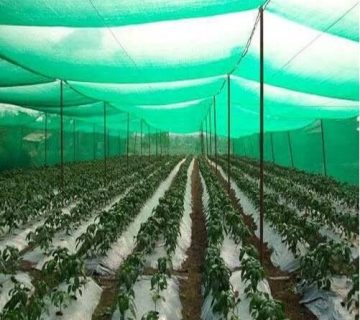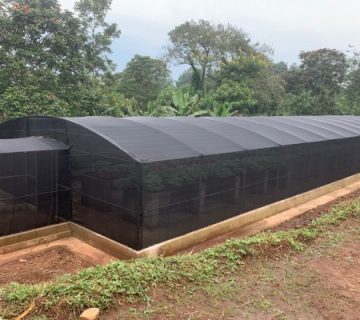Let’s start with the purpose of a shade cloth before discussing shade cloth for cucumbers. When the sun’s rays need to be blocked, shade cloth is what you use. Fabrics like this are commonly fabricated from Polyethylene (PE). They find widespread application in landscape design for a patio or greenhouse. In addition to their aesthetic value, they serve as an additional barrier against various pests.
Even fewer plants can tolerate constant direct sunlight. Many can get burned, dry out, and wilt because the heat is so intense. However, the cucumber can maintain its coolness even when temperatures soar. But even plants that thrive in the sun can only take a limited amount of heat.
Cucumbers (Cucumis sativus) thrive in hot conditions, but it’s not uncommon to come across a plant wilting due to too much direct sunlight. While heat stress can cause cucumber plants to collapse, it is more likely to reduce the yield, which is still frustrating when you’ve put in a lot of time and energy to grow them. As luck would have it, these issues can be sidestepped by simply using shades. Continue reading to find out more.
Percentage of shade cloth for cucumbers
Which plants you want to grow will determine how much sun protection you need. Low percentages density shade cloth is ideal for growing vegetables, including tomatoes, peppers, squash, and cucumbers. Extra lighting and manual pollination are often required for these plants. So be sure to consider this percentage regarding shade cloth for cucumbers.
Shade percentages between 40 and 60 percent are ideal for most plants (except for cucumbers and a few) since they reduce the sun’s intensity without completely blocking it. Shade net with a proportion of 50 percent is a safe bet for many plants, including many types of vegetables and flowers. Shade fabric materials, as you probably know, vary in how much light they let through to the ground. A density of 30% means that only 30% of light is obstructed, while the other 70% can travel freely.
Color of shade cloth for cucumbers
There are many more colors than the five most common ones: white and green. Each contributes to plant development in unique ways. As a result of selectively filtering out certain wavelengths of light, different colors can be used to achieve various effects on the incoming light; depending on what the plant needs, this might have either a positive or negative effect.
Shade cloths of dark colors like black and green are effective heat sinks and UV shields.
The sun’s rays are reflected and diffused by the white shade cloth. It filters out less light without degrading the quality of the emitted rays. Compared to black, it has a cooling effect on the greenhouse effect.
Cucumber growers generally use blue shade cloth for cucumbers. The optimal color for growing lettuce is red (or black).
When do cucumbers typically need a shade cloth?
When temperatures rise over 85 degrees Fahrenheit, shade becomes necessary for cucumbers. So, a shade cloth should be hung to prevent the leaves from burning.
How can you keep cucumbers safe from heat? A brief guide to shade cloth for cucumbers installation.
If you want to use shade cloth for cucumbers, here are the steps you should take:
Get Everything You Need
Using even basic shade strategies can significantly reduce the temperature that plants like cucumbers are exposed to. Several strategies exist for achieving this goal. Get started by rounding up some plant pegs and shade fabric. Utilizing a laundry basket on its side works, too, if the plants are small enough, and so can similarly using a garden umbrella.
Beginning Preparations
Set the stakes up around the spot you want to have shade. Leave at least two to three feet of space between the stakes and the plants’ tops for air circulation. To guarantee that the space is shaded during the hottest part of the day. As the sun sets, you may want to consider elevating one end above the other.
Place the Fabric
Attach the cloth to the stakes by tying it to the tops or using the loops or holes in the fabric. Dark shade cloth will absorb a great deal of heat during the day, so keep it away from the tops of your plants. Shade fabric of a lighter hue can come into contact with the plants without harm, as it will deflect the sun’s rays. Make sure your creation is sturdy enough to withstand the wind and is positioned correctly to cast a comfortable shade all day long.
Never Stop Caring For Cucumbers
Ensure the soil doesn’t dry out too much if the weather is too hot. Don’t let the soil dry out too much at any spot deeper than 2 or 3 inches around the cucumbers. If the top four inches of soil become dry, thorough watering is required.
Mulching Your Plants Might Be a Good Idea.
Mulching can also reduce soil temperature and limit evaporation on hot days. Cover the ground around the plants with a 2- to 3-inch layer of dry leaves or compost.
Conclusion
Remember, sunlight is vital for plant development and health. But different plants have different requirements for brightness and temperature. Using appropriate shade structures and cloth for cucumbers can improve their health and production. Even heat-loving plants like cucumbers can be harmed by too little or too much exposure to light, so be sure to use shade cloth for cucumbers when needed.




No comment